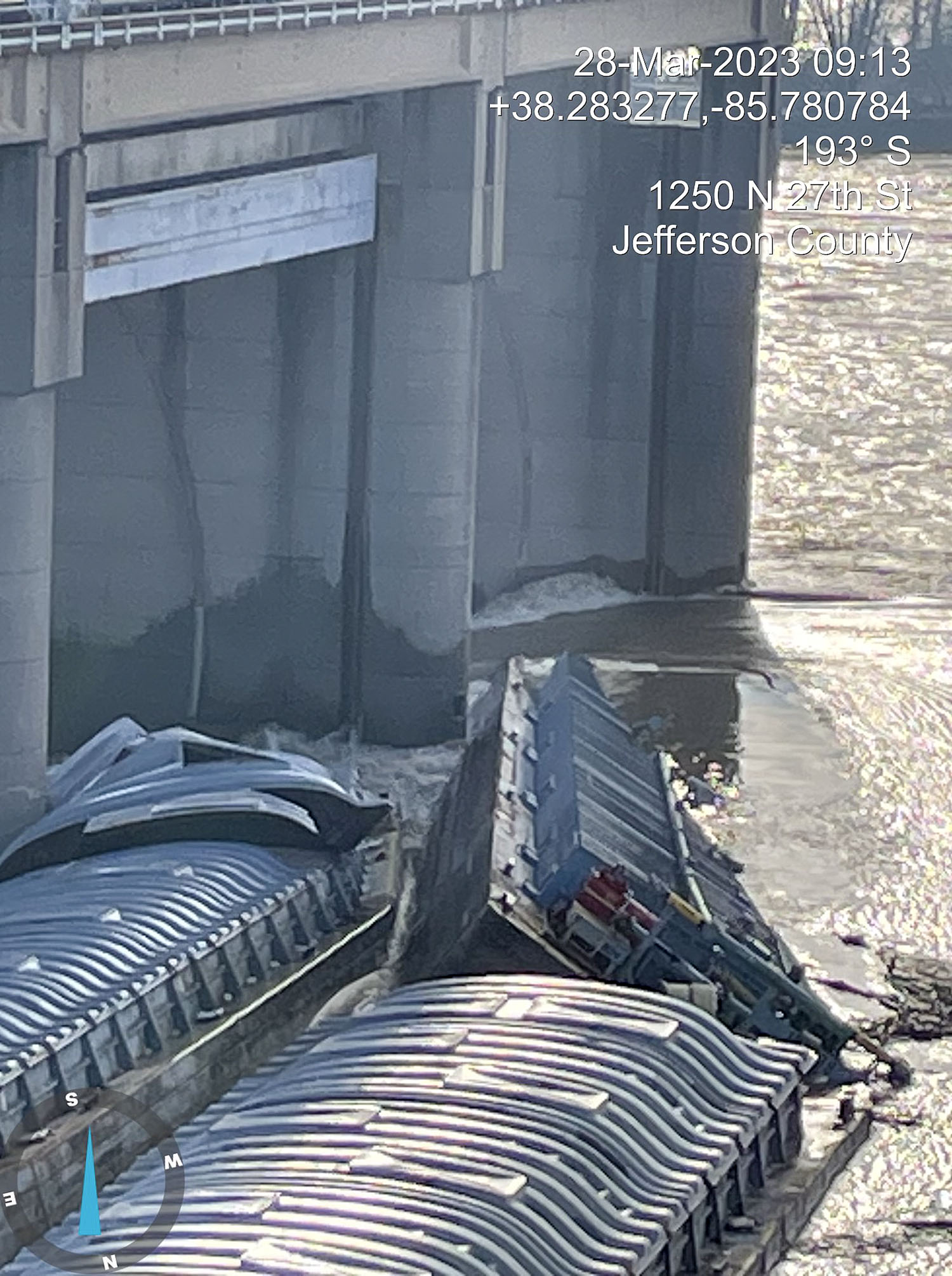Note: This is an updated version of a story that was posted the morning of March 29.
The locks at McAlpine Locks and Dam reopened the evening of March 28, roughly 17 hours after barges broke loose from a vessel and became pinned against the dam at Ohio River Mile 606.8, near Louisville, Ky.
Restrictions remained at the site that require southbound traffic to use a helper boat through local vessel traffic services, according to Louisville Emergency Management.
Shortly after 2 a.m. March 28, a vessel with 11 barges in tow made contact with a stationary structure at the entrance to the Portland Canal near McAlpine Locks and Dam, according to a news release from Louisville Emergency Management. As a result, 10 of the 11 barges broke loose, and three became lodged against the lower dam.
One barge became pinned against the Louisville & Indiana Railroad bridge, but it had been removed by early afternoon.
Vessels in the area recovered all the remaining barges.
During a media conference the afternoon of March 29, officials said crews had removed one of the two hopper barges carrying corn that were pinned against the dam, although one remained. The other barge that remains pinned against the dam is carrying approximately 1,400 metric tons of methanol.
“More than 80 air quality samples have been taken so far, and all tests to date show no evidence of hazards that would pose a health risk, though teams are continuously monitoring the situation,” Louisville Mayor Craig Greenberg said. “We are also taking water samples on a regular basis. Again, there is no evidence of any leaks at this time.”
The barge carrying methanol is partially submerged, according to the Kentucky Energy and Environment Cabinet. Rob Blair, an environmental scientist for the cabinet, said at the media briefing said that if all the methanol was to be discharged into the river at once, the effects could include a fish kill and that wildlife could be affected up to 15 miles downstream. The dam is located downstream from Louisville’s water intake, and the next municipal water intake is 200 miles downstream in Henderson, Ky., and it would not be affected, Blair said.
The cabinet was monitoring water quality monitoring as far as 3 miles downstream of the dam in five locations on a daily basis as well as sampling air quality both upstream and downstream on both sides of the river, he said.
John Roberts, president and CEO of Ingram Barge Company, said that although Ingram would like to emphasize that the company was not operating the vessel and tow when the barges broke away, “Those are our barges out there on that dam, and we are going to be responsible for getting them off in a safe manner. We’re committed to doing what it takes to make that right.”
Ingram has had representatives on-site since shortly after the barges broke loose, Greenberg said. The company has brought in T&T Salvage to assist in the salvage of the remaining two barges along with air and water monitoring teams that will be taking over testing moving forward.
Roberts thanked all local, state and federal agencies working with the incident command, along with Ingram associates and others the company has brought in to assist in the salvage.
“Ingram is a proud member of the Kentucky business community with over 400 associates residing in the commonwealth,” he said. “This is incredibly important to us.”
Roberts also said transparency is important to Ingram as the company works to salvage the barges and thanked media members for their attendance.
“It is our primary objective for the safety of this community and all of the citizens who live in this area and also the personnel who are involved in the recovery operations,” he said. “We’re going to do this, and we’re going to do it right, and we’re going to make sure we don’t take a bad incident and make it worse.”
While taking questions from the media, Roberts said it will be important to close some of the dam’s gates and build up a pool, decreasing the current on the lower side of the dam before attempting to remove the methanol barge.
“We believe that the pressure of the current right now is what is pinning the barge against the dam,” he said.
Once the current decreases, the methanol barge should refloat itself, he said.
Roberts also brought forward Kevin Teichman of T&T Salvage to give further information about the barges against the dam.
Teichman said it is apparent that the side shell of the hopper barge has been damaged in one of the barge’s double bottoms. With the methanol barge, no damage is visible on its stern, but “we have seen some damage on one of the double bottoms as well,” he said.
“Normally, before we would lift a barge like this, we would remove the product,” Teichman said. “Right now it’s just not safe to go on board. We’re still seeing some minor changes.”
He stressed that the organizations involved in recovering the barges are still in the early stages of planning.
U.S. Coast Guard Capt. Heather Mattern, captain of the port for Sector Ohio Valley, which is based in Louisville, would not provide any details regarding the vessel involved or other details concerning the barge breakaway, citing an ongoing investigation.
She also highlighted the potential dangers of salvage operations in what she called the “dynamic river environment.”
“So this will take some time because we want to make sure that we’re prioritizing safety for the community and our community that we live in, the workers who are working on this salvage operation and also the environment.”
Caption for photo (click on image for full photo): Two of three barges remain pinned against the lower dam at McAlpine Locks and Dam after breaking away from a towboat early March 28. Ten of 11 barges broke loose from a vessel, with one hitting a railroad bridge before being removed. (Photos courtesy of the Kentucky Energy and Environmental Cabinet.)



